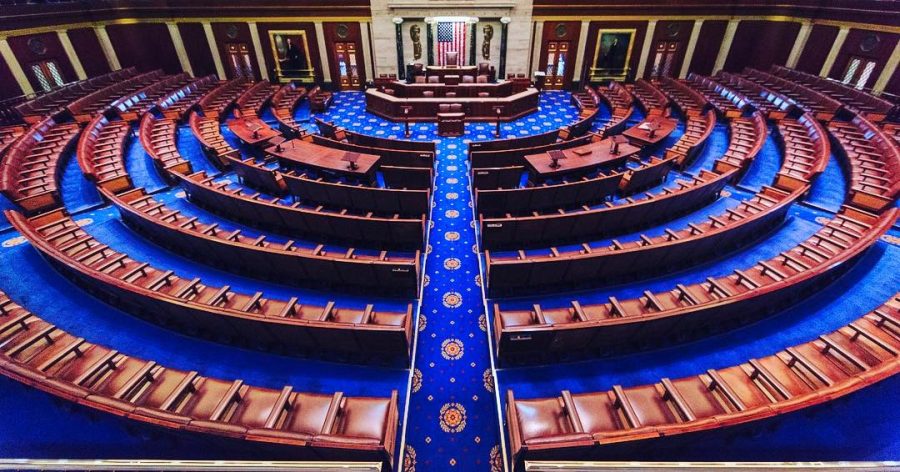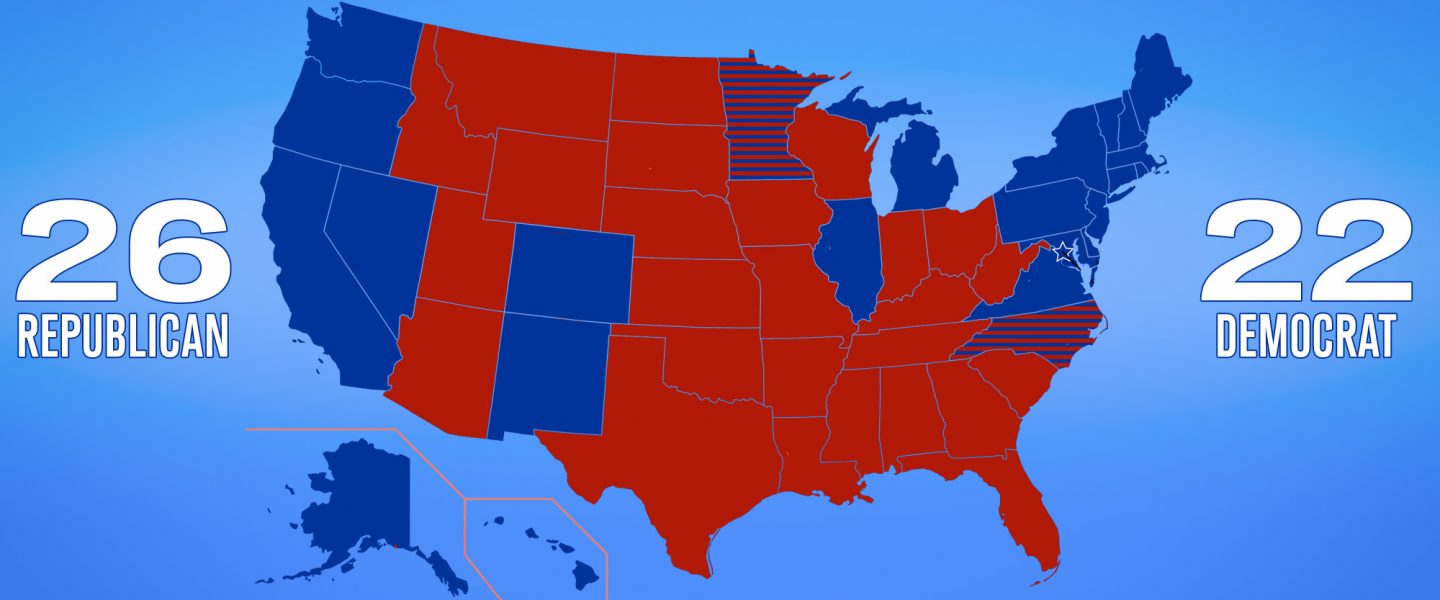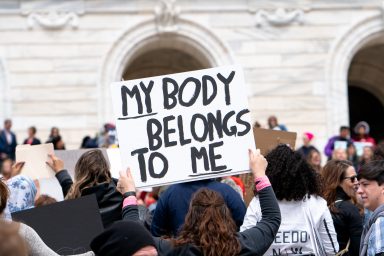There are constitutional crises and constitutional crises: There was Watergate and there was the Civil War. There is no way of knowing which kind the aftermath of Election 2024 might bring.
|
Listen To This Story
|
I know it’s still early — or would be, if 2024 were a “normal” election year — but I keep getting asked: What happens if the presidential election winds up in the House?
There are basically two ways in which this scenario — technically known as a “contingent election” — could happen:
1) If dispute over one or more states’ slate of electors results in no presidential candidate securing the 270 certified electoral votes necessary for election;
2) If one or more third-party candidates win one or more states (or electoral votes in Maine or Nebraska, which award some electors by congressional district), such that no candidate reaches 270.
Number 1 almost came to pass in 2020 (technically January 2021), when Donald Trump’s strategy was to prevent the certification of enough of Joe Biden’s electors to pull Biden below 270 and throw the election to the House. Although Congress has since passed reforms to the Electoral Count Act that should make that stunt more difficult to pull off, such a scenario cannot be completely ruled out for 2024.
But the scenario currently of greater concern, and prompting most of the questions I’ve been asked, is Number 2, the potential impact of third-party candidates. There is no shortage of those. As of now we have Robert F. Kennedy Jr., encouraged and promoted by none other than burn-it-all-down Steve Bannon; Cornel West; Jill Stein; and whomever the ostensibly centrist but largely right-leaning, oligarch-funded No Labels — which Robert Reich labeled as a “dark money front group for Donald Trump” — decides to put up if they move forward with their plan.

Flesh Wounds Can Be Fatal
Logic tells us that this expanded field will do serious harm to Biden’s prospects of defeating Trump, and that is in fact the prevailing consensus. A recent national poll showed Trump’s margin of 4 points in a head-to-head contest with Biden expanding to 6 points in a contest including the candidates above, with Sen. Joe Manchin (D?-WV) heading the No Labels ticket.
Two percentage points may seem something of a flesh wound but, if it plays out across the crucial swing states, it could be fatal to Biden — and, incidentally, given Trump’s proclivities and stated plans, to American democracy.
Both Ralph Nader in 2000 and Jill Stein in 2016 captured a smaller share of the vote in key battleground states, but in both cases post-mortem analyses showed their presence played a role in swinging the election to Republicans George W. Bush and Trump respectively.
So there is ample reason for concern that this lineup of third-party candidates could shift the outcome of the 2024 presidential election without coming close to winning a single state or electoral vote.
Also worth noting, Stop the Steal 3.0 is waiting in the wings for any state where the third-party candidates draw enough votes to narrow a solid Biden win into a squeaker. The Democrats are alarmed at the prospect of such a scenario, and rightly so.
But for the House to become the decider in a contingent election — if no electors are disqualified and barring an extremely unlikely 269-269 tie — it would require a third-party candidate to win at least some electoral votes. That almost certainly would mean winning a state — though, theoretically, picking off one or more electoral votes in the non-winner-take-all states of Nebraska and Maine could do the trick.
Gaming It Out
There is no current candidate polling ahead of both Biden and Trump in any state, but the one thing we know about 2024 is that it is loaded with unknowns. So let us examine how the process would play out if in fact one or more third-party candidates captured one or more states and the election was thrown to the House (pragmatically, at this point, an appealing No Labels “unity” ticket would pose the most serious threat to win some electoral votes, followed distantly by Kennedy).

Buckle up — it could be a very wild ride.
The 12th Amendment to the Constitution — ratified in 1804 to clean up the hash the Founders unwittingly made in Article 2, Section 1, which quickly reared its head in the messed-up election of 1800 — revised the Constitution’s provision for the conduct of a contingent election.
The fundamentals are fairly simple: The House chooses the president from among the top three Electoral College vote-getters, the Senate chooses the vice president from the top two vice-presidential vote-getters (I’ve yet to find anyone who can explain the rationale for the three versus two). In the Senate, each member has one vote and a majority of the total (i.e., 51 at the current time) is needed to elect a VP. In the House, however, voting is by state delegation, with a majority of the total delegations (i.e., 26 of 50 at the current time) required to elect a president.
If that last sentence strikes you as something of a teaser for chaos and a constitutional crisis, go to the head of the class. Because, while the amended Constitution lays out what looks like a tidy little process for deciding who will next occupy the White House, it leaves quite a bit unaddressed — and a great deal to be fought over, no holds barred, with just one ultimate outcome in mind.
Let’s look at the thing chronologically. Election Day 2024 is Tuesday, November 5, and ordinarily there would be a president-elect by the end of the week, if not sooner. But both the last two elections have spawned challenges and allegations (in 2016 by Stein, in 2020 by Trump) that led to protracted periods of uncertainty. There is every reason to believe 2024 will follow suit, most likely at an even higher pitch. Unless, of course, it is an Electoral College landslide without enough close states to leave the outcome in any doubt — a highly unlikely scenario.
So we should be prepared for a murky post-election interval, even if no third-party candidate is able to win any electoral votes and hence either the Democratic or Republican nominee claims a 270+ majority. That claim may well be disputed, as in 2020, with litigation and audits and recounts — and litigation over the conduct of audits and recounts — to be expected.
And we should note here the standing asymmetry of the post-election battlefield, where Democratic candidates historically have been quick to concede — even when presented with compelling data and analysis suggesting further investigation would be warranted — while Trump calls the election “rigged” in advance and takes it from there if not happy with the results.
GOP Majority of State Delegations a Lock
If a third-party candidate does, however, snag even a few electoral votes such that no candidate reaches 270, things will get a good deal dicier in a big hurry.
The sheer number of contingencies is dizzying and every one of them would be at least a skirmish and more likely a full-blown pitched battle in the larger war. I can shed some light on the shoals to be navigated in the form of a few questions — some procedural, some political — that will have to be answered.
- Which party will control the majority of state delegations in the House?
For those who regard a second Trump term as the footstomp of doom, this is where the bad news begins. The current lineup is 26 to 22 in favor of the GOP, with two delegations evenly split. If a contingent election were held today, there is little doubt that the Republican nominee would win it. Since a new House will be seated on January 3, 2025, before the actual contingent election would take place (on January 6), is it possible that in that new House, the GOP would lose its bare minimum margin?
Well, anything is possible, including an asteroid hitting the Capitol, but the probability for those two events is roughly the same because, as can be deduced by cross-referencing the aforementioned lineup with any listing of competitive races, GOP control of the delegations of every one of those 26 states is locked in to the point where it would take an overall Democratic landslide of epic proportions to pry even one state free. But of course such a landslide would essentially preclude the possibility of a contingent election in the first place and make the question moot.
So it is more than safe to assume that, in the event of a contingent election, the GOP will control a majority of state delegations in the new House. In fact, because either of the two evenly split delegations, and several delegations narrowly controlled by the Democrats, could wind up with GOP majorities, 26 delegations should be regarded as a floor for GOP control, with the ceiling as high as 32.
The actual number is important because it will determine whether Trump (assuming he is the GOP nominee) would face any danger from an intra-party revolt by “moderates” in even a single state, bearing in mind that the No Labels or other third-party candidate who has even a few Electoral College votes would be, by the terms of the 12th Amendment, included in the three-candidate contingent election field and available as a “compromise” choice.
And that, in turn, is important. Because if one or more state delegations were to “go rogue” and choose that third candidate, whoever they might be — leaving both major party nominees short of the necessary 26 states — whoa Nelly! Simply put, there would be no president, and no provision to choose one, leaving it to the Senate (which might well be divided 50 – 50) to pick a vice president, who would presumably become president, at least until the whole thing was somehow sorted out. The prospect of an evenly divided Senate deadlocked over, say, Kamala Harris and Elise Stefanik, gives me goosebumps.
How Do You “Do” a Contingent Election?
- If no candidate for president has a 270+ electoral majority when the votes are counted on January 6, an “immediate” contingent election is prescribed by the Constitution. How is it to be conducted?
Aye, there’s the rub. Or at least one of them. The 12th Amendment tells us the states will cast votes by delegation and that a majority (26) of all the states is needed to elect the president. It tells us that a member of the delegation from two-thirds of the states (34) must be present as a quorum for this vote to take place — which means that neither party could unilaterally block the vote via boycott, as the Democrats have at least one member of 39 delegations and the GOP 40, neither in danger of falling below the 34-state threshold.
But that’s about all the Constitution tells us. Here are some of the things it doesn’t tell us:
-
-
- What determines for whom a given state delegation can cast its vote? Is it a simple majority of representatives present, a simple majority of the full delegation, a supermajority, a mere plurality?
- How long is “immediately” (the language of the 12th Amendment)? How much time for deal making and horse trading?
- Who, if anyone, chairs each delegation’s caucus? How is the chair chosen? What if the delegation is evenly divided D/R, as Minnesota and North Carolina now are?
- If there’s disagreement on any of these, or other, procedural points, who resolves it and how — a House committee, the full House, the House speaker, the courts?
-
Where the Constitution is silent, it will fall first to the House itself to set the rules and procedures for the contingent election. That leads back to two more critical questions:
- Which party will command a House majority if and when a contingent election takes place?
- Who will be House speaker and what promises regarding the conduct of the contingent election will he or she have made to secure the post?
A Long Two Months
And these questions, in turn, take us back to the chronology of the post-election period. Between Election Day (November 5, 2024) and Certification Day (January 6, 2025) there is a vast expanse of two months during which, as we saw in the election of 2000 and again in the election of 2020, there are various processes and deadlines, and opportunities for much fierce and frenetic activity.
In “normal” times, it should be apparent within a few days of Election Day at the latest which candidate has secured an Electoral College majority and is the president-elect — and, by the same token, if a third party has snagged enough votes to deprive both major party candidates of the necessary 270 Electoral College votes.
But these are not normal times and it is far from fantastical to imagine a Stop the Steal 3.0 campaign (one that has learned from its 2020 predecessor’s mistakes) placing one or more states’ Electoral College votes in dispute, perhaps invoking some species of “independent state legislature” approach, such that no candidate arrives at January 2025 with clear title to the necessary 270 votes, regardless of whether a third party candidate has received any.
In the midst of this potential turmoil and dogfight, if there is any prospect at all of a contingent election coming to pass, control of the House (and to an only slightly lesser extent the Senate) would become crucial. As noted above, the GOP will almost certainly retain a majority of state delegations, but control of the overall House majority would allow the party that achieves it to set the critical rules for the anticipated contingent election process, as well as, presumably, choosing the speaker, who would then exercise considerable power over the rule-setting process itself.
The new House would be sworn in on January 3, 2025; and traditionally a speaker would also be chosen, from the majority party, at that time. But there are 435 voting House members and good prospects for the 2025 House to be very narrowly divided, as is the current House. With the presidency, as well as control of the House itself, at stake, in the era of Stop the Steal election denial, if control of the House were to come down to a handful of close elections, what are the odds that the apparent losers gracefully concede — especially, it must be said, the ones taking orders from Trump?
Thus, November and December could see a rash of disputes over both state-level presidential results and district-level congressional results and even state legislative control in closely divided states, along with challenges to electors, and likely involvement of both federal and state courts, as we saw in both 2000 and 2020.
Fire Burn and Cauldron Bubble?
That turmoil — coupled with the prospect of a contingent election when and if the preliminary dust finally settled, with not just Trump but the ultra-MAGA House Freedom Caucus in the mix — might well prove too much of a strain for the Constitution itself and a politicized judicial branch to handle.
With political violence crescent and all but normalized; with Trump egging on his MAGA mob, extolling them as martyrs and “hostages”; with January 6, 2021, as their dress rehearsal; with both sides prepared to regard the results as existential; with a new poll showing that fully 77 percent of 2020 Trump voters are not inclined to accept the results of the 2024 election unless Trump is the winner; and with a posse of MAGA influencers, as if to back up those poll results, just last week screaming “fraud” and “Democrat shenanigans” over Trump’s loss, by a single vote, to Nikki Haley, of a single Iowa county out of 99 (it apparently was not enough for him to win the other 98 counties and the state by 30 points) — it is not wildly alarmist to view these various post-election scenarios as highly fraught and perilous.
There are constitutional crises and constitutional crises: There was Watergate and there was the Civil War. There is no way of knowing which kind, if any, the aftermath of Election 2024 might be, how off the rails, how deadly.
But it is fair to say that the presence of one or more viable third-party candidacies, particularly a No Labels “unity” ticket — coupled with the prospect of election denialism and the persisting flaws and vulnerabilities of our voting and vote counting systems — raises the distinct possibility of the “bad” kind of constitutional crisis, the kind where cooler heads can find no way to prevail.
Jonathan D. Simon is a senior editor at WhoWhatWhy and author of CODE RED: Computerized Elections and the War on American Democracy.





